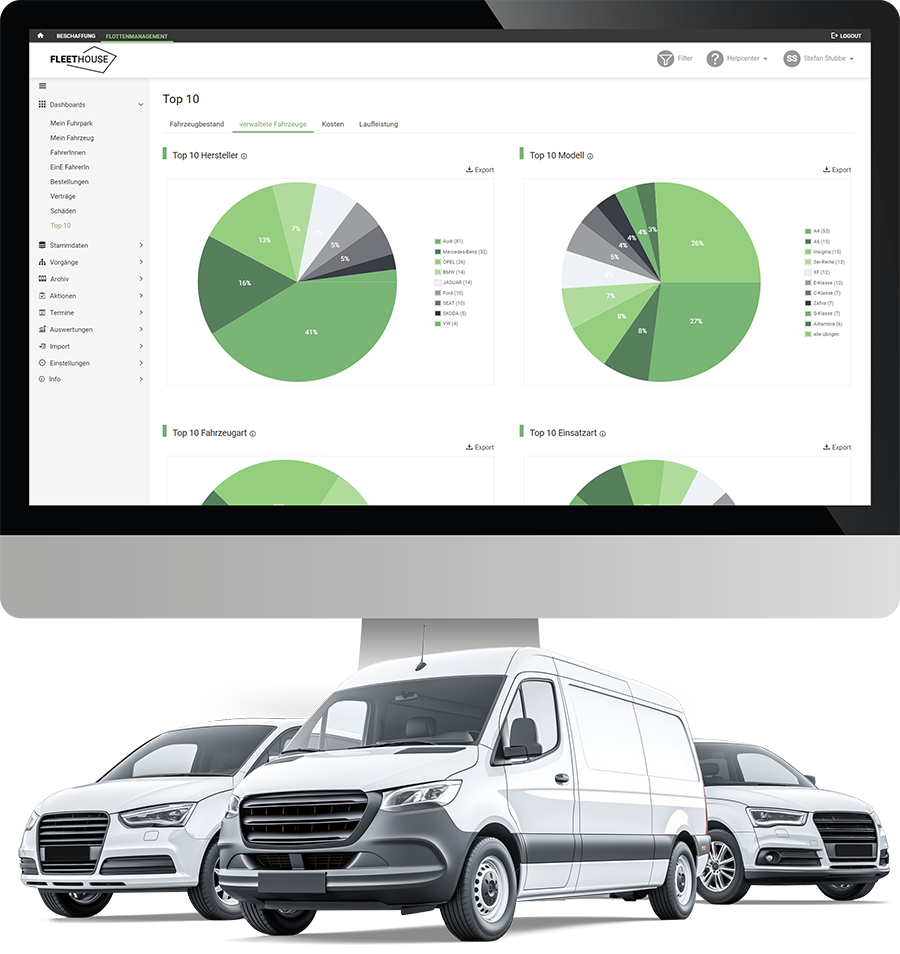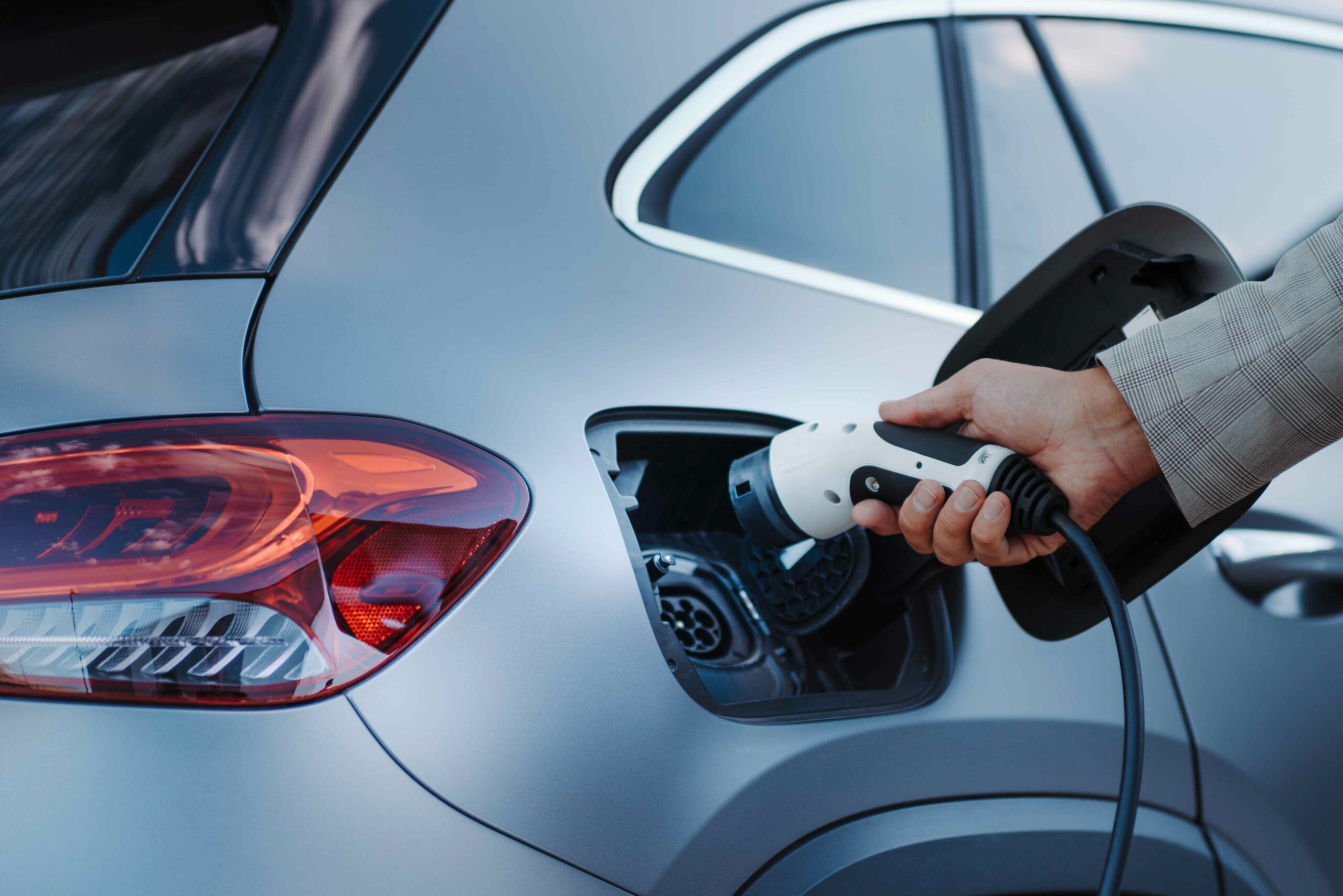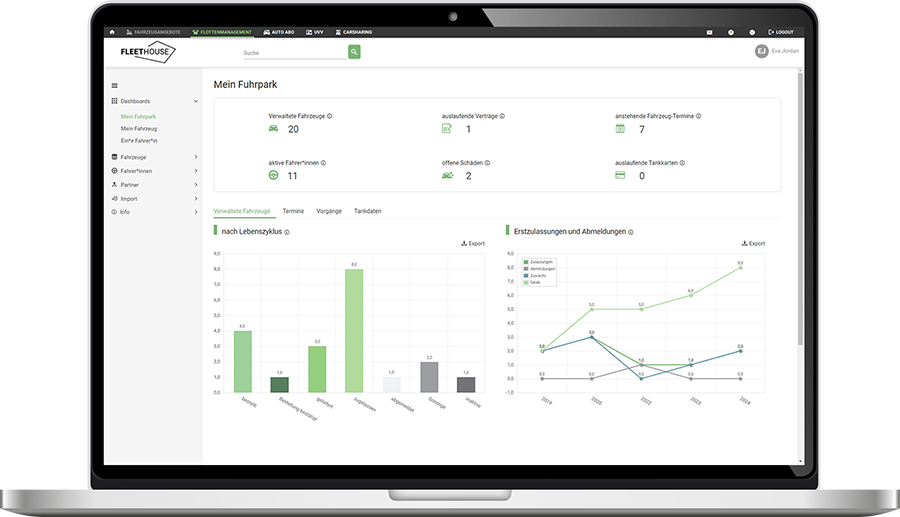A well-organized vehicle fleet is a decisive factor for many companies. Whether for sales, field service or logistics – an efficiently managed fleet saves costs, increases productivity and ensures reliable mobility for employees. But which vehicles are needed? Which financing models make sense? And how can administration and maintenance be optimized? In this article, you will find out what is important when setting up a vehicle fleet, what options companies have and how digital fleet management can help.
Contents
What is a vehicle fleet?
A vehicle fleet is a group of several vehicles that are centrally managed and operated by a company, an organization or a public institution. These can be cars, vans, trucks, buses or special vehicles – depending on the industry and purpose. The fleet is usually used to perform operational tasks efficiently, such as the transportation of goods, employee mobility or on-site customer service.
It is important that the vehicles are not managed individually, but are systematically planned, maintained and controlled as an overall unit. This includes the procurement, use, maintenance, insurance, management and decommissioning of the vehicles. The larger and more diverse the fleet, the more complex the requirements for fleet management – which is why many companies now rely on professional fleet management software or external service providers.
Examples of vehicle fleets
Vehicle fleets are as individual as the companies themselves. Very different vehicles are used depending on the sector and purpose. Typical examples are
Sales fleets with compact company cars for the sales force
Service and trade fleets with vans for fitters and technicians
Delivery fleets with vans or trucks for logistics and e-commerce companies
Municipal fleets with refuse collection vehicles, gritters or emergency vehicles
Care services and social institutions with small cars for mobile teams
Rental car fleets of large providers
Car-sharing or pool vehicles that can be used flexibly by employees
These examples show how versatile vehicle fleets can be – always adapted to the specific requirements of day-to-day business.
Why is a well-organized vehicle fleet crucial for companies?
A well-structured vehicle fleet is a central component of operations for many companies and offers numerous advantages – first and foremost flexibility and independence: instead of having to rely on external service providers, companies can organize and manage their own mobility as required. This allows deliveries to be made on time, service calls to be carried out directly at the customer’s premises or internal processes to be organized more efficiently. This ensures smooth mobility for employees and enables profitable use of vehicles.
Especially in the logistics and service sector, having your own fleet is a strategic advantage: it allows you to react quickly to order changes, plan individual routes and optimize vehicle utilization. Thanks to modern technologies and digital
Whether you are a trade business, transport company or field service organization: a professionally managed vehicle fleet is a key success factor for smooth processes, high service quality and sustainable competitiveness.
But without well thought-out planning, a fleet can quickly lead to high costs and organizational problems. Modern fleet management not only reduces fuel consumption, it also makes it easier to coordinate maintenance and comply with legal requirements. By focusing on optimized management from the outset, you can secure long-term savings and optimize operational processes. Instead of relying on external service providers, companies can design and manage the mobility they need themselves in line with their requirements.

The software for your vehicle fleet
Manage your fleet with Fleethouse – digitally, efficiently and transparently.
Determining requirements: Which vehicles are right for my company?
Before companies set up a vehicle fleet, they should carefully analyze which fleet vehicles are needed. The selection ranges from classic cars for sales to commercial vehicles for delivery services and electric vehicles for
The question of financing is also important: is leasing the better option or is it worth buying? Alternatives such as
Buying, leasing or car subscription - the right procurement strategy
When building up a fleet of vehicles, the question of optimal financing arises. While buying a company car can be cheaper in the long term, leasing offers more flexibility. Many companies now rely on a mixture of different models in order to both save costs and optimally manage operational requirements. In addition, fleet managers should plan and prepare discussions with partners well in advance in order to negotiate the best conditions.
If you want to switch to a sustainable fleet, you should look into the possibility of introducing electric vehicles. These not only offer advantages in terms of fuel consumption, but can also be interesting due to tax benefits. In addition, modernizing the vehicle fleet with environmentally friendly drives can bring long-term savings and reduce CO₂ emissions. A well thought-out renewal of the vehicle fleet is therefore not only economical, but also ecologically sensible.
Overall, the choice of the right procurement strategy depends heavily on the individual priorities of the company – both economic and sustainable aspects should be taken into account.
Sustainability in the vehicle fleet: environmentally conscious management
Sustainability is no longer a “nice-to-have”, but an important competitive factor – also in the vehicle fleet. Companies that rely on an
Telematics systems also help to analyze driving behavior, save fuel and reduce emissions. Strategic deployment planning – e.g. through route optimization or pooling – also improves the fleet’s carbon footprint.
For companies with sustainability goals or CSR requirements, a “green fleet” also sends a strong signal to the outside world: to customers, business partners and employees. Funding programs at federal and state level also support the switch to alternative drive systems.

Manage vehicle fleets efficiently: Digitization and processes
Profitable fleet management starts with clear organization and the right software. Innovative vehicle fleet management tools, such as Fleethouse, help to regularly monitor maintenance schedules, optimize vehicle usage and keep an eye on costs. Digital solutions that enable a comprehensive analysis of the fleet by evaluating vehicle data in real time are particularly helpful.
Fuel cards also play a role: they make billing easier and offer opportunities for cost control. By digitalizing the entire fleet, the company can work more economically in the long term.
Insuring your vehicle fleet - which insurance policies make sense?
Without suitable insurance, the vehicle fleet is exposed to a high financial risk. Among the most important insurances are liability insurances and comprehensive insurances. Special fleet insurance policies can also be taken out. These can not only cover accidents and damage, but often also offer special conditions for special vehicles and for companies with many vehicles.
In addition, the claims rate can be reduced through driver training and an anticipatory driving style. Companies should also examine premium models that offer potential savings through the use of telematics systems.

Manage your vehicle fleet - for just €2.90 per vehicle per month
Legal framework conditions: What you should bear in mind when operating a fleet
Anyone who operates a fleet of vehicles must comply with legal regulations. These include regular vehicle inspections in accordance with accident prevention regulations (UVV), UVV driver training and driving license checks as part of owner liability. The GDPR-compliant use of GPS tracking and telematics is particularly important. Violations can not only result in penalties, but also jeopardize smooth operations.
Keeper obligations: Safety and documentation
The following measures are mandatory in order to comply with legal requirements:
- UVV inspection: Regular technical inspection of vehicles in accordance with accident prevention regulations.
- Instruction when handing over the vehicle: Instruction in accordance with the accident prevention regulations when handing over a vehicle protects the company from possible recourse claims in the event of an accident at work.
- UVV driver training: Annual driver training on safe behavior and legal obligations.
- Driving license check: Systematic and documented check that drivers have a valid driving license.
Important: All measures must be fully documented – violations can result in personal liability for those responsible.
Data protection: using GPS and telematics in compliance with the law
The same applies to the use of digital systems such as telematics or GPS tracking:
- Minimize data collection: Only collect the data that is required for the operational purpose.
- Purpose limitation and transparency: Employees must be informed about the type, scope and purpose of data collection.
- Ensure a legal basis: Either by consent or via a clear legal basis (e.g. legitimate interest).
Attention: Violations of the GDPR can result in high fines and damage to your image.
Additional legal requirements depending on use
Depending on the type and area of use of the fleet, further regulations may be relevant:
- Driving Personnel Act: Compliance with driving and rest times.
- Dangerous Goods Ordinance: Special requirements for the transportation of dangerous goods.
- Registration and approval requirements: Especially for commercially used vehicles or special vehicles.
Digital support: organizing the fulfillment of duties efficiently
To comply with all regulations, many companies rely on:
Digital fleet management tools
Automated driver’s license checks
Cloud-based documentation of all test and training certificates
This allows legal obligations to be fulfilled efficiently while minimizing operational and personal risks.
Do you keep an eye on your vehicle fleet?
Find out how you can manage your fleet efficiently with Fleethouse.

7 steps to a successful vehicle fleet - how to set it up successfully
A successful vehicle fleet is based on a well thought-out strategy and economical management. Here are the most important steps for building an economical, modern and sustainable fleet:
- Analyze requirements & select vehicles: Determine which vehicles – whether passenger cars, commercial vehicles or electric vehicles – are necessary for your business. Take into account operational requirements and economic aspects.
- Determine your procurement strategy: Weigh up between buying, leasing or car subscription. Fleet managers should obtain official offers at an early stage and agree individual conditions.
- Digitize fleet management: An innovative vehicle fleet requires innovative management software, such as Fleethouse, to keep track of maintenance appointments, driver data and vehicle costs.
- Consider sustainability & modernization: Rely on environmentally friendly technologies and consider replacing the fleet with electric vehicles or alternative drives. This saves costs in the long term and reduces CO₂ emissions.
- Meet legal requirements: Comply with legal requirements such as driver’s license checks, accident prevention regulations and data protection guidelines. Clear documentation and continuous training are crucial here.
- Optimize insurance & cost control: Compare rates for fleet insurance and explore ways to reduce costs through smart driving or digital vehicle monitoring.
- Regular maintenance & fleet optimization: Sustainable optimization requires continuous inspections and ongoing analysis of fleet efficiency. This keeps the vehicle fleet economical and future-proof.
Following these steps will ensure that the vehicle fleet is operated economically and modernized sustainably – a win-win situation for any company. Building a vehicle fleet requires strategic planning and smart decisions. From choosing the right vehicles and procurement to digitalization and maintenance, companies need to take numerous factors into account. Modern fleet management not only saves costs, but also increases the cost-effectiveness and future viability of the fleet. Those who opt for digital solutions at an early stage and observe legal requirements will secure long-term benefits and optimal use of their vehicle fleet.
Arrange an online consultation appointment
Arrange your personal consultation appointment now. You can easily select a suitable appointment using our booking tool.

Anne Fuchs

Ciara Lazeta
FAQ - Frequently asked questions about the vehicle fleet
A vehicle fleet comprises several company vehicles that are used for business purposes. It enables companies to organize their mobility, reduce costs and optimize the transport of employees or goods. It also includes motivational vehicles for employees, which are intended exclusively for private use.
The choice depends on the intended use. Typical vehicles are cars, vans, trucks or e-vehicles, but company bikes or special vehicles can also be part of the fleet. Low operating costs, suitable charging or transport capacity and long-term cost-effectiveness are important.
Digital fleet management software, such as Fleethouse, can be used to optimize vehicle usage, maintenance and costs. Continuous maintenance, fuel management and the use of telematics systems improve efficiency.
The costs vary depending on the type of vehicle, financing (purchase, leasing, car subscription) and ongoing expenses for insurance, maintenance and fuel. Savings are possible through pooling, optimized routes and low-cost insurance.
Companies must ensure that their vehicles are roadworthy and that owner liability obligations are complied with. Data protection guidelines play a role in GPS tracking, and commercial drivers are subject to driving and rest periods. Those who ignore these requirements risk high penalties and liability problems – legally compliant fleet management is therefore essential.
A company fleet is defined as a fleet of two or three regularly used company vehicles. In practice, professional fleet management usually starts at around five vehicles – depending on the industry and organizational structure.
CO₂ emissions can be reduced through the use of electric vehicles, hybrid models or alternative fuels (HVO), as well as optimized deployment planning. Telematics systems also help to analyze driving behavior and save fuel. Subsidy programs can facilitate the changeover.
The most important facts about the vehicle fleet
A well-organized vehicle fleet helps companies to reduce costs and optimize employee mobility. Clear processes and the use of fleet management software allow vehicles to be used in a targeted manner.
A well thought-out vehicle fleet enables better utilization of the vehicles and thus reduces acquisition, maintenance and insurance costs. In addition, fuel consumption can be reduced through targeted measures.
Modern software facilitates fleet management and ensures legally compliant driver's license control. This ensures that operations remain legally compliant and efficient at all times.
Further Fleet Knowledge
If you liked this article and would like to know more about this topic, we recommend these articles.


Vehicle management: importance in the fleet and helpful tips

Car subscription: When is it usefull for your company?

E-car as a company car: taxes, costs and insurance
Further blog articles on the topic of vehicle fleets
Fleet management: basics and helpful tips
Fleet Manager: Tasks, Qualifications and Salary
Fleet at a Glance: Importance, Trends and Technologies
Fleet management without Excel: How to save time and money
Measures for sustainable fleet management
Fleet insurance for your vehicle fleet: this is what matters
Fleet app – how to manage your fleet digitally and efficiently




